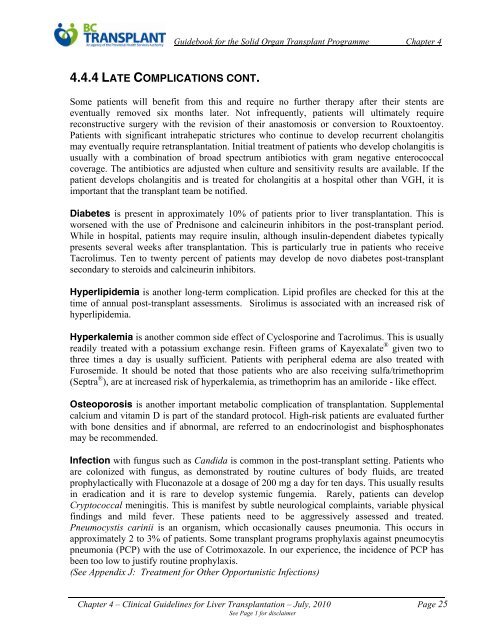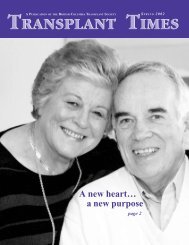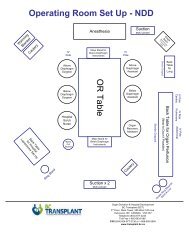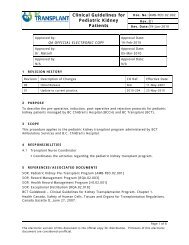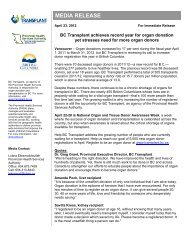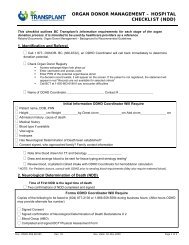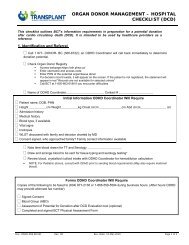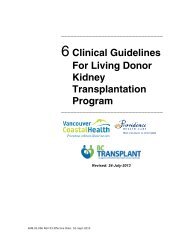4. Clinical Guidelines for Liver Transplantation (PDF) - British ...
4. Clinical Guidelines for Liver Transplantation (PDF) - British ...
4. Clinical Guidelines for Liver Transplantation (PDF) - British ...
You also want an ePaper? Increase the reach of your titles
YUMPU automatically turns print PDFs into web optimized ePapers that Google loves.
Guidebook <strong>for</strong> the Solid Organ Transplant Programme Chapter 4<br />
<strong>4.</strong><strong>4.</strong>4 LATE COMPLICATIONS CONT.<br />
Some patients will benefit from this and require no further therapy after their stents are<br />
eventually removed six months later. Not infrequently, patients will ultimately require<br />
reconstructive surgery with the revision of their anastomosis or conversion to Rouxtoentoy.<br />
Patients with significant intrahepatic strictures who continue to develop recurrent cholangitis<br />
may eventually require retransplantation. Initial treatment of patients who develop cholangitis is<br />
usually with a combination of broad spectrum antibiotics with gram negative enterococcal<br />
coverage. The antibiotics are adjusted when culture and sensitivity results are available. If the<br />
patient develops cholangitis and is treated <strong>for</strong> cholangitis at a hospital other than VGH, it is<br />
important that the transplant team be notified.<br />
Diabetes is present in approximately 10% of patients prior to liver transplantation. This is<br />
worsened with the use of Prednisone and calcineurin inhibitors in the post-transplant period.<br />
While in hospital, patients may require insulin, although insulin-dependent diabetes typically<br />
presents several weeks after transplantation. This is particularly true in patients who receive<br />
Tacrolimus. Ten to twenty percent of patients may develop de novo diabetes post-transplant<br />
secondary to steroids and calcineurin inhibitors.<br />
Hyperlipidemia is another long-term complication. Lipid profiles are checked <strong>for</strong> this at the<br />
time of annual post-transplant assessments. Sirolimus is associated with an increased risk of<br />
hyperlipidemia.<br />
Hyperkalemia is another common side effect of Cyclosporine and Tacrolimus. This is usually<br />
readily treated with a potassium exchange resin. Fifteen grams of Kayexalate ® given two to<br />
three times a day is usually sufficient. Patients with peripheral edema are also treated with<br />
Furosemide. It should be noted that those patients who are also receiving sulfa/trimethoprim<br />
(Septra ® ), are at increased risk of hyperkalemia, as trimethoprim has an amiloride - like effect.<br />
Osteoporosis is another important metabolic complication of transplantation. Supplemental<br />
calcium and vitamin D is part of the standard protocol. High-risk patients are evaluated further<br />
with bone densities and if abnormal, are referred to an endocrinologist and bisphosphonates<br />
may be recommended.<br />
Infection with fungus such as Candida is common in the post-transplant setting. Patients who<br />
are colonized with fungus, as demonstrated by routine cultures of body fluids, are treated<br />
prophylactically with Fluconazole at a dosage of 200 mg a day <strong>for</strong> ten days. This usually results<br />
in eradication and it is rare to develop systemic fungemia. Rarely, patients can develop<br />
Cryptococcal meningitis. This is manifest by subtle neurological complaints, variable physical<br />
findings and mild fever. These patients need to be aggressively assessed and treated.<br />
Pneumocystis carinii is an organism, which occasionally causes pneumonia. This occurs in<br />
approximately 2 to 3% of patients. Some transplant programs prophylaxis against pneumocytis<br />
pneumonia (PCP) with the use of Cotrimoxazole. In our experience, the incidence of PCP has<br />
been too low to justify routine prophylaxis.<br />
(See Appendix J: Treatment <strong>for</strong> Other Opportunistic Infections)<br />
Chapter 4 – <strong>Clinical</strong> <strong>Guidelines</strong> <strong>for</strong> <strong>Liver</strong> <strong>Transplantation</strong> – July, 2010 Page 25<br />
See Page 1 <strong>for</strong> disclaimer


